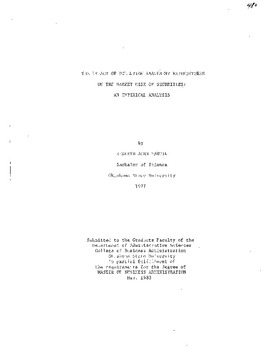| dc.contributor.advisor | Jackson, James F. | |
| dc.contributor.author | Martin, Kenneth John | |
| dc.date.accessioned | 2015-11-24T15:40:38Z | |
| dc.date.available | 2015-11-24T15:40:38Z | |
| dc.date.issued | 1980-05 | |
| dc.identifier.uri | https://hdl.handle.net/11244/22380 | |
| dc.description.abstract | Scope and Method of Study: This study, utilizing the Capital Asset Pricing Model, uses two separate, yet related, approached; to analyze the effects of pollution abatement expenditures on the risk of securities. The first approach, using data from the CRSP Investment Performance File, tests for any changes in systematic risk (beta) and in unsystematic risk (standard error) each for three portfolios in three consecutive, nonoverlapping periods. The first portfolio consists of 40 firms which are in industries generally thought of as polluters while the other two are randomly generated control portfolios. The total time interval in this approach is from January 1953-December 1978. The second approach differs in the construction of the portfolios and the time interval. All industries with pollution abatement expenditures are divided into three portfolios; high, medium, and low expenditures. Yearly beta and standard error values are calculated for the firms in these industries for the years 1973-1978. Changes in the risk factors across this time period are examined. | |
| dc.description.abstract | Findings and Conclusions: The empirical results of this paper do not provide support for the hypothesis that pollution control legislation has adversely affected market risk of securities. The results of the first technique of analysis show no significant change in beta values for the polluting portfolio between any of the periods of time under consideration while the betas for the control portfolios did change significantly. All three of the portfolios showed a significant increase in no market risk (standard error) between periods two and three. The results of the second technique of analysis support the first insofar as the relative magnitudes of the high, medium, and low categories of polluters are concerned. Contrary to the hypothesis, the high category of polluters experienced the lowest betas and standard deviations while the low polluters had the highest values for the sample time period 1973- 1978. Thus, it appears that market risk is unaffected by pollution control legislation over the long run. | |
| dc.format | application/pdf | |
| dc.language | en_US | |
| dc.rights | Copyright is held by the author who has granted the Oklahoma State University Library the non-exclusive right to share this material in its institutional repository. Contact Digital Library Services at lib-dls@okstate.edu or 405-744-9161 for the permission policy on the use, reproduction or distribution of this material. | |
| dc.title | Impact of pollution abatement expenditures on the market risk of securities: An empirical analysis | |
| osu.filename | Thesis-1980R-M831i.pdf | |
| osu.accesstype | Open Access | |
| dc.type.genre | Master's Report | |
| dc.type.material | Text | |
| thesis.degree.discipline | Finance | |
| thesis.degree.grantor | Oklahoma State University | |
